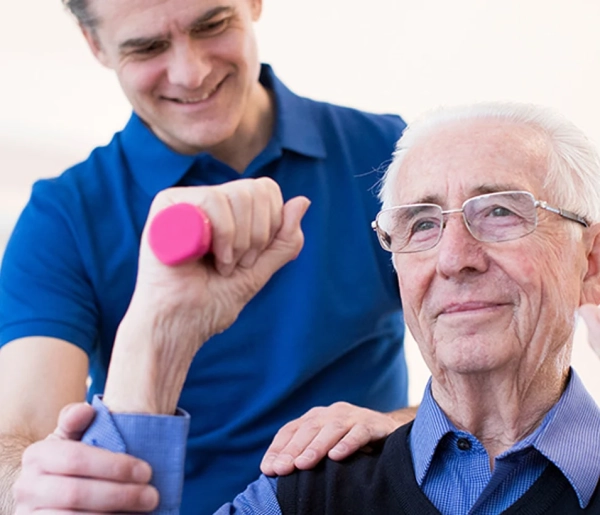Generally, this kind of injury (Spinal Cord Injury) leads to paraplegia. When this happens, you are unable to move the lower part of the body. It can also result in quadriplegia that is a complete loss of movement in your movement.
With a spinal cord injury, a patient can restore some movement after therapy and cord injury rehabilitation. However, they will still have long-term psychological and medical issues to deal with.


- Mechanical Ventilation Program
- — Weaning Program
- — Long Term Ventilated Patients
- Neuro Rehabilitation
- Musculoskeletal Rehabilitation
- Post Surgeries Rehabilitation
- Road Traffic Accident
- Pediatric Rehabilitation
- — Pulmonary Rehabilitation
- — Speech and Language
- — Neuromuscular Rehabilitation
- — Central Nervous System Anomalies
- — Long Term Care of Cardiac
- — Pediatric Transitional Care
- — Post Acute Care
- Long Term Care & Rehabilitation
- Outpatient Services
- Home Healthcare Services
Cambridge Medical & Rehabilitation Center (CMRC) is a leading provider of post acute rehabilitation services in the United Arab Emirates and Saudi Arabia. Our state-of-the-art facilities focus on enhancing patient quality of life through a holistic and interdisciplinary approach tailored specifically for individuals recovering from serious medical events.
Cambridge provides an interdisciplinary clinical approach for Spinal Cord Injuries which is customized for adults, adolescents, and children.
The best rehabilitation services are not only our goal but our ultimate objective is to customize the care plan for each patient and make sure that the patient’s family and their members are integrated into the treatment plan.
Experience comprehensive care with regular follow-ups, care coordination, and community support at CMRC—where your recovery journey feels like #YourSecondHome.
What is a Long-Term Spinal Cord Injury?
An injury to the spinal cord that damages the nerves and the spinal cord at the end of the spinal canal can cause permanent changes in sensation, strength, and other functional health problems.
When someone suffers a spinal cord injury, it might appear like your whole life has been affected. You can feel its effects emotionally, mentally, and also socially.
A spinal cord injury is usually a result of a violent or unpredictable event or accident. The following can cause damage to the spinal cord:
- An attack like a gunshot or stabbing
- Diving into the water, which is shallow, and then hitting the bottom
- Falling down from a considerable height
- Trauma in a car accident, particularly trauma to the head, face, back, neck, or chest area
- Spinal or head injuries in a sports event
- Serious twisting in the torso’s middle portion
- Electrical accidents
What are the Symptoms of a Spinal Cord Injury?
Some of the symptoms of developing a spinal cord injury are given below:
- Loss of control of the bowels or bladders
- Issues with walking
- Inability to move legs or arms
- Unconsciousness
- Feelings or spreading numbness in the extremities
- Headache
- Unconsciousness
- Signs of shock
- Pressure, pain, and stiffness in the neck or back area
- Head’s unnatural positioning
If you think that you or someone has suffered a spinal cord injury, you need to follow the procedure given below.
- You need to call help immediately. So, the sooner the help arrives, the better it is for you
- Avoid moving or disturbing them unless it is truly necessary. Avoid removing the person’s helmet
- In case the person is not breathing, you can perform a CPR
When you suffer a spinal cord injury, the medical consequences that you will experience are as follow,
- Respiratory failure
- Bladder control
- Urinary tract infections
- Pneumonia
The psychological impacts of this are substantial. Many patients who suffer from this injury might experience anxiety or depression.
However, once the patient crosses the milestone of returning home, he or she has to conquer all his or her barriers to returning to society. This is the reason rehabilitation important when it comes to achieving complete after spinal cord injury.
What is the Role of Rehabilitation for Patients with Spinal Cord Injury?
A majority of the people who have new spinal cord injuries will require a rehabilitation team to help them out. This is mainly to gain independence and learn new ways to perform daily activities.
After completing rehabilitation under acute care, social workers will guide the patients, as well as their families, to choose the right rehabilitation facility.
Choosing the Right Rehabilitation Facility
If it better when the patient’s loved one makes the final decision on which is the right rehabilitation center for the patient?
As a family member, you can take a tour of the institution and ask the rehabilitation nurses about the therapy. This will give you a feel for the whole facility. In case you cannot tour it in person, you can take the help of video tours if available.
Things to Expect in a Rehabilitation Facility
Patients usually move to a rehabilitation hospital when they are medically stable and can achieve their independence if required. It is a crucial time for the patients because of several locomotor training skills that patients benefit from occurring during this time.
The improvement that you see during this time sets the stage for the recovery of patients. Albeit, traumatic spinal cord injury patients, need occupational therapy and physical therapy, the pace of recovery varies with each patient.
To maximize your recovery, a rehabilitation center will always come up with an individualized plan. So, they can get back to a healthy lifestyle in no time.
The patients who are admitted to a rehabilitation facility can tolerate just 15 hours of therapy in 7 days. In this program, patients go for therapy from occupational therapists. Apart from this, they also go for physical therapy for restoring physical activity.
The caregiver or the family of the patient needs to accompany the patient in their occupational and physical therapy sessions. They are trained to take care of the patient at home. A support system is important for optimizing spinal cord injury rehabilitation.
Before starting with patient care, the facility will always determine the person’s injury level and will list the health problems that can arise. The primary aim of the rehabilitation facility is to achieve her or his maximum potential. Based on this, there are many therapies, these include
- Range of motion exercises
- Muscle strengthening
- Gait training
- Transfer training
- Diaphragm pacing system
- Assistive devices training
- Fertility and sexuality management
- Wheelchair and seating clinic
- Family, patient, and peer mentoring
- Speech therapy
All these are done through an inter-disciplinary approach. One of the fields that have received great attention in the last few years is body weight bear support training.
Recovering your walking ability after a spinal cord injury is a primary goal. Studies have shown that with proper health care, it is possible to regain your ability to walk. Educational therapy is mainly to improve your quality of life.
Educational Opportunities in Rehabilitation
Inpatient Rehabilitation provides several educational opportunities. Developing a spinal cord injury is a significant life event that can lead to serious physical problems and secondary complications. This has a severe impact on life satisfaction.
According to studies, life satisfaction has improved in several spinal cord injury patients after going into rehabilitation healthcare facilities. Recovery of life satisfaction refers to:
- Physical capacity
- Functional independence
- Wheelchair mobility
In an inpatient rehabilitation program, you will also have to go through educational sessions with nursing and therapy. With proper medical care, the spinal cord will again see the blood flowing.
Spinal Cord Surgery
At times the injury might be so severe that a rehabilitation program might not be enough. This might lead to bedsores and pressure sore. Taking your health condition into account, spine surgery can be performed immediately or even later.
Urgent intervention is required for patients with incomplete SCI. Surgery might also be done if the neurologic dysfunction worsens. The operation decision depends on various circumstances like the extent and the cause of the injury.
Surgery might not be able to reverse the problem of spinal cord damage. However, spinal stabilization and decompression are important for preventing deformity, pain, neurologic deficit, etc.
How to Diagnose a Spinal Cord Injury?
One of the first steps taken to diagnose an injury to the spinal cord is a physical examination and medical history.
- Your physician is going to take a medical history and ask you questions about the details that surround the time of injury
- The amount of time gone by after the injury is also important as it is a medical emergency.
The quicker you get the treatment, the better chance you have of recovering - The other details of medical history might include details of previous back or neck surgeries or injuries, any weaknesses, and the presence of pain in the back or neck
- Traumatic injuries might lead to heart attack, elevated blood pressure, and various other health issues
- The physician will examine to find out if the sensation of touch is still intact in the legs and arms
- They will also test reflexes and muscles in the legs and arms
- The patient might be kept in a cervical collar for immobilizing them till the doctor can decide if or not the patient has spinal cord injury. This is mainly to ascertain health conditions
Bottom Line
In case you or your loved one has suffered a spinal cord injury, it is always a good idea to get in touch with a health care specialist so that you know what you have to do. Whenever you experience trauma in your neck or head, you should go for an immediate medical evaluation to prevent spinal injury.
As a matter of fact, it is safe to assume that trauma victims have spinal cord injury until it is proven otherwise. A severe spinal injury isn’t always obvious. So, if you don’t recognize and get it treated on time, a serious injury might occur. Paralysis or numbness can occur immediately or gradually.
At times, only after bleeding or swelling around the spinal cord do you experience numbness and paralysis. The time between treatment and injury is crucial in deciding the severity and extent of complications.
Spinal cord injury is serious. So, you should always take proper care to prevent it.